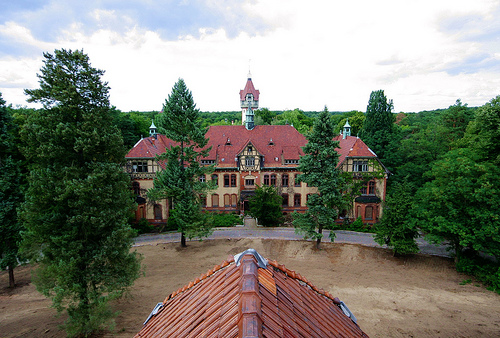

Location: Brandenburg Map
Constructed: 1898
Architect: Heino Schmieden
The Beelitz Heilstätten Military Hospital, often simply referred to as Beelitz-Heilstätten, is a sprawling abandoned complex of approximately 60 buildings spread across nearly 200 hectares in the forested district of Beelitz-Heilstätten, near the town of Beelitz in Brandenburg, Germany. Originally constructed as a sanatorium for treating lung diseases like tuberculosis at the turn of the 20th century, it evolved into a major military hospital during both World Wars, notably treating Adolf Hitler in 1916 after he was wounded in the Battle of the Somme. Post-World War II, it served as a Soviet military facility until its abandonment in 1994, leading to decades of decay that have transformed it into one of Europe's most iconic "lost places" or urban exploration sites. Today, the site blends haunting ruins with partial redevelopment, attracting history buffs, photographers, and tourists interested in dark tourism. Parts of the complex are accessible via guided tours and a modern treetop walkway, offering safe vantage points over the overgrown, graffiti-covered structures that evoke a mix of historical significance and eerie abandonment. Visitor ratings average around 4.5 out of 5 on platforms like Tripadvisor, praising its atmospheric allure, though some note the physical demands and safety restrictions.
The origins of Beelitz-Heilstätten date back to 1898, when
Berlin's Landesversicherungsanstalt (health insurance authority)
acquired about 140 hectares of pine forest land to establish a
workers' sanatorium amid a tuberculosis epidemic ravaging industrial
cities. Construction occurred in phases: the first section opened in
1902 with 600 beds for men, followed by a women's section in 1907
adding another 600 beds. By 1930, the complex had expanded to
accommodate up to 3,000 patients, featuring state-of-the-art
facilities like pavilions, kitchens, and power plants, designed with
fresh air therapy in mind—patients were often treated on open
balconies.
World War I drastically altered its purpose; from 1914
to 1918, it was converted into a military hospital treating over
10,000 soldiers. Notably, a young Adolf Hitler was admitted in
October 1916 for a leg wound sustained in combat, spending about six
weeks recovering and later referencing the site in "Mein Kampf."
After the war, it reverted to civilian use but was repurposed again
during World War II as a military hospital under the Nazis, serving
wounded troops and even high-ranking officials. In April 1945, as
the war ended, it briefly hosted German army command before being
captured by the Red Army.
Under Soviet occupation from 1945 to
1994, Beelitz-Heilstätten became the largest Soviet military
hospital outside the USSR, treating up to 1,500 patients, including
notable figures like Erich Honecker (East Germany's leader) in 1990
and Soviet soldiers injured in Afghanistan. The facility included
specialized departments and even a small town-like infrastructure.
After the Soviet withdrawal in 1994, the site was largely abandoned,
leading to vandalism, looting, and natural decay. In the 2000s,
parts were sold for redevelopment—some buildings were renovated into
apartments or medical centers, while others remain ruins. It gained
pop culture fame as a filming location for movies like "The Pianist"
(2002) and "Valkyrie" (2008), and a 2001 murder case involving a
photographer added to its macabre reputation. Preservation efforts
began in the 2010s, including the addition of a treetop path in 2015
to allow safe public access.
Beelitz-Heilstätten is located in the Beelitz-Heilstätten district,
approximately 50 km southwest of Berlin and 20 km south of Potsdam, in a
dense pine forest that was chosen for its clean air beneficial to lung
patients. The coordinates are around 52°15′N 12°55′E, making it easily
accessible by train from Berlin (about 40 minutes to Beelitz-Heilstätten
station) or car via the A9 highway. The complex spans a vast, wooded
area, with buildings clustered in sections: the men's sanatorium to the
north and women's to the south, separated by railway lines and paths.
Architecturally, the buildings reflect late 19th- and early 20th-century
styles, primarily Art Nouveau and historicist influences, with red brick
facades, arched windows, turrets, and tiled roofs now often collapsed or
overgrown with ivy and trees. Key structures include the Alpine House
(Alpenhaus), a massive pavilion with vaulted ceilings and green-painted
interiors; the Central Bath House; and various pavilions like the
Lungenheilstätte (lung healing station). Many buildings feature
Liegehallen (open-air resting halls) for fresh air therapy. The site's
isolation in the forest enhances its ghostly atmosphere, with overgrown
paths and scattered debris contributing to the sense of abandonment.
The site's primary draw is its ruins, where visitors can explore
decaying hallways, operating theaters, and wards filled with peeling
paint, shattered glass, and graffiti. Notable features include the
treetop walkway (Baumkronenpfad), a 320-meter elevated path rising
up to 23 meters high, offering panoramic views over the Alpine House
ruins without entering unstable areas. This steel structure includes
viewing platforms and informational panels on the site's history and
ecology.
Guided tours delve into specific themes, such as the
"Lost Places Tour" exploring restricted ruins or historical walks
covering WWII and Soviet eras. The area also supports biodiversity,
with forests reclaiming buildings—trees growing through roofs and
wildlife inhabiting the grounds. Some sections have been repurposed:
a neurological rehabilitation clinic operates in one part, and
residential developments are underway in others. However, much
remains off-limits due to collapse risks, with fences and security
patrols enforcing access restrictions.
Beelitz-Heilstätten's historical ties to Hitler make it a poignant reminder of Germany's turbulent past, often sparking debates on preservation versus redevelopment. Its role in Soviet history, including treating figures like Honecker, adds Cold War layers. The site's eerie aesthetics have inspired artists and filmmakers, but it has also seen tragedies, like accidents from unauthorized exploration and the aforementioned 2001 murders. Ecologically, the forest integration highlights nature's reclamation, with the area now part of protected green spaces.
As of October 2025, Beelitz-Heilstätten is managed by entities like Baum & Zeit GmbH, focusing on safe, educational tourism. Unauthorized entry into ruins is prohibited and can result in fines or arrests due to dangers like collapsing structures.